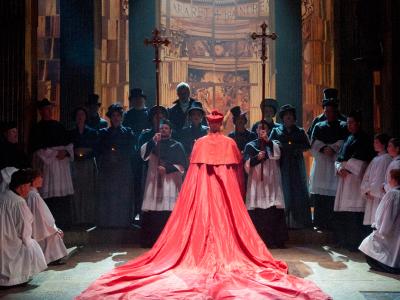Discover Pagliacci
Italian composer Ruggero Leoncavallo’s Pagliacci opera explores the blurred lines between art and reality.
Set among a travelling commedia dell’arte troupe, leader, Canio, who discovers his wife Nedda’s infidelity. Driven by jealousy, Canio brings the drama of their play tragically to life, murdering Nedda and her lover, Silvio, during a performance. The opera includes the iconic aria “Vesti la giubba”.
In the ENO’s contemporary version, directed by Richard Jones with a libretto by playwright and screenwriter Lee Hall, the group are now an ensemble of ageing comics from a 1970s’ TV show. They’ve been renamed Kenny, Nelly and Tony and the opera sees them touring theatres with a new show.
Explore the gripping and tragic story of Leoncavallo’s Pagliacci below with a detailed synopsis, discover the complex emotions of key characters, and enjoy snapshots from previous ENO productions.
Pagliacci Synopsis
The Comedians: English adaptation by Lee Hall
Tony, a comic, tells us that what we are about to see is real.
The comedians arrive to perform a show and are greeted by an enthusiastic crowd.
Nelly – the leading commedienne – fears the jealousy of her husband Kenny, the leading comic. She is revolted by the harassment of the second comic, Tony.
She meets her lover Woody, the stage carpenter. Woody persuades her to leave the theatre and escape with him after the show that night. Tony spies on Nelly and Woody, and alerts Kenny to their relationship. Kenny rounds upon Nelly furiously. He meditates on how he must make an audience laugh while inwardly despairing.
An excited audience arrives for the show and the comedy begins. Kenny however arrives on stage, unable to separate his life from the play in which he performing . . .
Pagliacci FAQs
What is Pagliacci about?
Pagliacci is an Italian opera which falls under the ‘verismo’ opera genre, a late 19th century composition which focuses on real-life subjects.
The plot focuses on an Italian theatre group, where the leader Canio discovers his wife is having an affair with a villager. The lines between reality and performance begin to blur within the chaos of a small Italian village, causing an overwhelmed and jealous Canio to confront Nedda, his wife, on stage.
A meeting of rage and horror follow, concluding in a tragic display of jealousy.
Who was Pagliacci?
Canio, the main character, portrays a character named Pagliacci, who becomes central to the meaning of the opera.
Translating into English as ‘clown’, Pagliacci becomes a symbol of a tragic clown, someone who appears joyous but is experiencing emotional turmoil on the inside.
How do you pronounce Pagliacci?
The G is silent in Pagliacci, following the pronunciation: “pah-lee-AH-chee”.
How long is Pagliacci?
A performance of Pagliacci is roughly 1 hr 15 mins and is often performed without an interval.
Who composed Pagliacci?
The music and libretto for Pagliacci was written by composer Ruggero Leoncavallo, premiering in Milan, Italy in May 1892.



